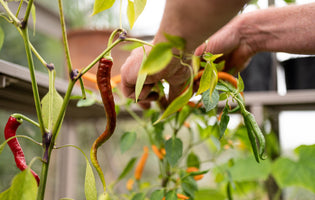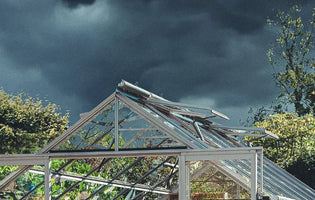If there are easier ways to achieve your gardening ambitions, wouldn’t you want to know what they are? It could be getting rid of garden pests in an eco-friendly way, preventing weeds from coming through, and which plants to plant where. You may want to go as environmentally conscious as possible in the garden and at home. Or it could just be gardening on a budget.
We’ve compiled a handy list of gardening hacks that really do work. Some you will know, some are common gardening hacks, and others are a little more ‘outside the box’ but give them a go.
A compendium of garden hacks
Gardeners everywhere have discovered easy ways to recycle and reuse things from the garden and find useful solutions for common problems. So, here are our top 14 gardening hacks you may find handy.
-
Plant-in-a-pot
Ever planted something only to find that it’s grown too big for that bed, or doesn’t fit in with your other plants, want to experiment with color or need to bring it in during winter? Well, this method is a surefire way to make it ultra easy. Double up on the pots and then plant/replant them. You’ll need pots the same size, then just slot the plant in its pot inside another pot and plant them to ground level. When you want to change things around, lift out the top pot and slot in another plant. -
Easy lawn edging
Make a neat, straight edge to your lawn or flower beds by putting down a piece of wood approximately 6x2. Put a foot on the board, place a spade flat against it and with your other foot, push the spade down until it cuts through to the desired depth. As you go along the edge, move the board as necessary. -
Mini bottle greenhouses
If you don’t have a greenhouse and want to sow a few seeds or bring on cuttings, here’s the answer. Get a plastic two-liter soft drink/soda bottle, remove the labels and cut off the bottom. Then sit it on top of your cuttings or seeds in a pot. Once the seeds have started to grow or the cuttings have rooted, you can remove your mini-bottle greenhouse. -
Cardboard seed tubes
Instead of spending money on seed trays, save the cardboard inner tubes from toilet and kitchen paper. Cut them into lengths of about two inches and stand them up in a waterproof tray. Fill the tubes with compost and plant your seeds. When they’re ready to plant out, you can put them in the ground in the tubes, as the cardboard will decompose. If you don't have any cardboard tubes, make them out of old newspapers. Put four sheets together, cut into three strips and roll each one up. -
Reuse your coffee grounds
Don’t throw out your used coffee grounds, as there are several ways to recycle them in the garden. Adding them to your compost adds nitrogen and, when used as a fertilizer, they add nitrogen to acidic soil. They will also deter annoying pests, like slugs and snails, keep cats off your flower beds, and worms love them! -
Make your own watering can
Get a large plastic milk jug, cut some holes in the lid, fill it with water, and you have a homemade watering can. You may have to fill it up a few times, but it’s ideal for patio and balcony gardens. -
Sweeten your tomatoes
Finding homegrown tomatoes are a little tart? Get some baking soda and sprinkle it around the bottom of the plants. It reduces the soil’s acidity and makes your tomatoes sweeter. -
Sprinkle the cinnamon
This popular kitchen spice has antifungal properties, and when sprinkled around the base of seedlings, it helps to prevent diseases. Oh, and it smells nice! -
Get planting herbs
No, not for cooking but for your garden. Some herbs are great at preventing mosquitos and flies. Get a largish garden pot and grow citronella geranium, lemongrass, lemon thyme, marigold ‘Lemon Gem’, ageratum ‘Artist Purple’ and catnip together. -
Prevent the weeds
Mulch is a great way to prevent weeds from coming through but, if you haven’t got any mulch, reuse your newspapers or cardboard boxes flattened out and spread them over your beds and borders to smother any weeds. -
Space out seeds evenly
Mark out shallow holes for seeds in the ground using a muffin tin. Just press the tin into the prepared soil, and you’ve got perfectly evenly-spaced holes in which to plant your seeds. -
Reuse your pruned twigs and branches
Instead of breaking them down for composting or getting rid of them in the garden waste bin, keep some of them back. The shorter twigs are perfect as pea sticks to support growing pea plants. The longer twigs are ideal for sweet peas to grow up. You can also use them on your beds and borders to keep cats off them and to prevent birdlife, like pigeons, from disturbing recently sown seeds and seedlings. -
Keep tools free from rust
It can’t be helped; tools rust in the damp air, particularly over winter and when they get wet. A good way to maintain them is to dry them off after use with a handy towel, oil the blades and any moving parts, and then sink the blades into a bucket or container filled with sand. Not only is it a great way to keep them in one place so you don’t lose them, but the sand also stops rust from forming. -
Create your own watering system
You don’t need to spend a fortune on a watering system in container gardens or patios. Use a plastic or glass bottle to create a unique individual watering system for your pots, tubs and containers, even hanging baskets. With glass bottles, make a hole in the lid or cork, fill it with water, turn it upside down and insert it into the soil. The water will trickle out slowly and feed water to the plants. When it’s empty, just refill and start again. If you’ve nothing to make a hole with, loosen the screw lid instead. With plastic bottles, make a hole in the lid or neck of the bottle, fill it and insert it into the soil. The advantage of plastic bottles is that you can cut the bottom off so it’s open when sitting in the soil, making it easier to top it up. One thing to remember is to make sure the bottle is stable and won’t fall over.







